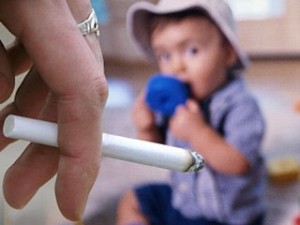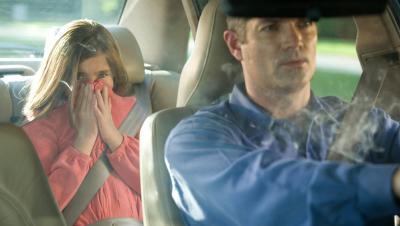What is Secondhand Smoke?
Secondhand smoke (also known as environmental tobacco smoke) is the smoke a smoker breathes out and that comes from the tip of burning cigarettes, pipes, and cigars. It contains about 4,000 chemicals. Many of these chemicals are dangerous; more than 50 are known to cause cancer. Anytime children breathe in secondhand smoke they are exposed to these chemicals.
Children and Secondhand Smoke Exposure
 Studies show that approximately 4 out of 10 U.S. children aged 3–11 years (40.6%) are exposed to secondhand smoke. In the U.S., the percentage of children and teens living with at least one smoker is about three times the percentage of nonsmoking adults who live with a smoker.
Studies show that approximately 4 out of 10 U.S. children aged 3–11 years (40.6%) are exposed to secondhand smoke. In the U.S., the percentage of children and teens living with at least one smoker is about three times the percentage of nonsmoking adults who live with a smoker.
Children who live in homes where smoking is allowed have higher levels of cotinine (a biological marker of secondhand smoke exposure) than children who live in homes where smoking is not allowed. Because their bodies are developing, infants and young children are especially vulnerable to the poisons in secondhand smoke.
Secondhand smoke can increase the risk of serious health problems for children or can make certain health conditions worse. For example, children who breathe secondhand smoke can have more ear infections, coughs and colds, and respiratory problems, such as bronchitis and pneumonia.
Impact on Hearing Health
Sometimes the effects of secondhand smoke aren’t immediately noticeable, but still have a significant effect on a child’s life. New research from Japan found has shown that exposure to smoking, both in utero and in the first few months of a child’s life, is associated with higher prevalence of hearing impairment.
The study, published online in Paediatric and Perinatal Epidemiology, studied data on 50,734 children who were born between 2004 and 2010. The researchers were most interested in the children’s hearing health at age three. Of the children, 3.8 percent were exposed to smoke only during their mothers’ pregnancies, 15.2 percent were exposed only by their mother’s past smoking habits, 3.9 percent were exposed only to secondhand smoke at four months old, and 0.9 percent were exposed to tobacco smoke both during pregnancy and at four months. The children’s hearing was tested in a whispered hearing test and parents smoking was measured by a questionnaire.
By age three, 4.6 percent of children had a type of hearing impairment. Results revealed a correlation between exposure to cigarette smoke and hearing impairment in the three-year olds.
Children exposed to only their mothers’ past smoking had a 26 percent increased risk of hearing impairment. Those exposed to only secondhand smoke at four months had a 30 percent increased risk. However, those whose mothers smoked during their pregnancy had a 68 percent increased risk of hearing impairment.
Although the study cannot prove that cigarette smoke exposure was the direct cause of the children’s hearing impairment, the researchers did note that preventing this exposure was a clear way to reduce the children’s risk.
“This study clearly shows that preventing exposure to tobacco smoke during pregnancy and postnatally may reduce the risk of hearing problems in children,” senior author Dr. Koji Kawakami, of Kyoto University in Japan, said in a statement. “The findings remind us of the need to continue strengthening interventions to prevent smoking before and during pregnancy and exposure to secondhand smoke in children.”
Secondhand Smoke is Everywhere
 Children can be exposed to secondhand smoke in many places. Even if there are no smokers in the home, children can still be exposed to secondhand smoke. These include:
Children can be exposed to secondhand smoke in many places. Even if there are no smokers in the home, children can still be exposed to secondhand smoke. These include:
- In a car or on a bus
- At child care or school
- At a babysitter’s house
- At a friend’s or relative’s house
- In a restaurant
- At the mall
- At sporting events or concerts
- In parks or playgrounds
Creating a Smoke-Free Environment
The following tips may help keep your children from being exposed to secondhand smoke:
- Set the example. If you smoke, quit today! If your children see you smoking, they may want to try it, and they may grow up smoking as well. If there are cigarettes at home, children are more likely to experiment with smoking—the first step in becoming addicted.
- Remove your children from places where smoking is allowed, even if no one is smoking while you are there. Chemicals from smoke can be found on surfaces in rooms days after the smoking occurred.
- Make your home smoke free. Until you can quit, don’t smoke inside your home and don’t smoke anywhere near your children, even if you are outside. Don’t put out any ashtrays. Remember, air flows throughout a house, so smoking in even one room allows smoke to go everywhere.
- Make your car smoke free. Until you can quit, don’t smoke inside your car. Opening windows isn’t enough to clear the air and can actually blow smoke back into the faces of passengers in the back seat.
- Choose a babysitter who doesn’t smoke. Even if the babysitter smokes outside, your children are exposed. Consider changing babysitters to find a smoke-free environment for your children.
- Encourage tobacco-free child care and schools. Help your children’s child care or school, including outdoor areas and teachers’ lounges, become tobacco free. Get your children involved in the effort to make schools tobacco free.
